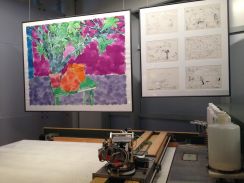Today, we had the privilege of listening to Tracy Ballinger’s presentation. She focuses on using graph theory to reconstruct the evolutionary history of cancer. She specializes in genome sequencing and bioinformatics. Her work is especially pertinent to our world today because 1 in 4 people will die from cancer in the U.S. Cancer is a genetic disease. They all have different perturbations and mutations, which make them very hard to cure in unique individuals. Cancer accumulates mutations over time; these mutations are called passenger mutations. Her work responds to the need to distinguish passenger mutations from initiators of the cancer. Using Copy Number Ancestral Variation Graphs (CN-AVG), Ms. Ballinger builds potential evolutionary histories from copy number changes. An evolutionary history is made up of a sequence of rearrangement events. The timing of when the cells were developed can be inferred through prevalence and parsimony. Ms. Ballinger also uses Markov Chain Monte Carlo (MCMC) sampling to generate history predictions. As the MCMC samplings iterate, the sampling results of independent histories reach a steady state of agreement. Her work uses AI in an innovative way.
Mr. Alston also spoke about his own research in Real-time Experience-driven Procedural Content Generation. His work is based on the assumption that different players play, experience, and enjoy games differently. The problem is that today’s games do not provide a different experience for individual players. ED-PCG incorporates player modeling, machine learning, and procedural content-generation methods. ED-PCG will hopefully occur online and in real-time in the near future. There is subjective, objective, and gameplay based player experience modeling. Subjective player experience modeling is how the players feel and is self reported. Objective player experience modeling forms from multiple modalities of player input. Finally, game play player experience modeling are things that come out of the game. This approach is online, necessary, parameter vector stochastic, generate and test. Its components include player and game data, content quality, content representation, and content generation. Mr. Alston demonstrated his game using Pro-D Procedural Dungeon Generation. It uses preference learning. The gameplay is assessed based on accuracy, feature subset, individual feature contribution, and training time. Hopefully video games can evolve to be adaptive systems based on player modules.
These two uses of AI are both impressive and inspiring. AI is being applied in concrete ways to benefit society and make boundary-pushing technological advances.


